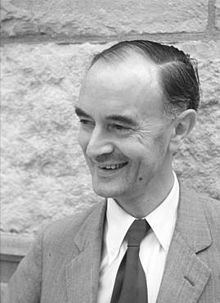Citizenship British English Role Chemist Name Christopher Ingold | Residence London, United Kingdom Nationality British | |
 | ||
Born 28 October 1893London, United Kingdom ( 1893-10-28 ) Institutions Imperial College LondonUniversity of LeedsUniversity College London Thesis Formation and stability of carbon rings (1921) Books Structure and mechanism in organic chemistry | ||
Sir Christopher Kelk Ingold (28 October 1893 – 8 December 1970) was a British chemist based in Leeds and London. His groundbreaking work in the 1920s and 1930s on reaction mechanisms and the electronic structure of organic compounds was responsible for the introduction into mainstream chemistry of concepts such as nucleophile, electrophile, inductive and resonance effects, and such descriptors as SN1, SN2, E1, and E2. He also was a co-author of the Cahn–Ingold–Prelog priority rules. Ingold is regarded as one of the chief pioneers of physical organic chemistry.
Scientific work
Ingold began his scientific studies at Hartley University College at Southampton (now Southampton University) taking an external BSc in 1913 with the University of London. After a brief time with Imperial College, London and some war service, as a scientist, Ingold earned an MSc degree, again with the University of London. He returned to Imperial College for work with Jocelyn Field Thorpe, and was awarded a PhD in 1918 and a DSc in 1921.
Ingold married Dr. Hilda Usherwood, a fellow chemist with whom he collaborated, in 1923. They had two daughters and a son the chemist Keith Ingold.
In 1924, Ingold moved to the University of Leeds where he spent six years as Professor of Organic Chemistry. He returned to London in 1930, and served for 24 years as Head of the chemistry department at University College London, from 1937 until his retirement in 1961.
During his study of alkyl halides, Ingold found evidence for two possible reaction mechanisms for nucleophilic substitution reactions. He found that tertiary alkyl halides underwent a two-step mechanism (SN1) while primary and secondary alkyl halides underwent a one-step mechanism (SN2). This conclusion was based on the finding that reactions of tertiary alkyl halides with nucleophiles were dependent on the concentration of the alkyl halide only. Meanwhile, he discovered that primary and secondary alkyl halides, when reacting with nucleophiles, depend on both the concentration of the alkyl halide and the concentration of the nucleophile.
Starting around 1926, Ingold and Robert Robinson carried out a heated debate on the electronic theoretical approaches to organic reaction mechanisms. See, for example, the summary by Saltzman.
Sir Christopher Ingold received the Longstaff Medal of the Royal Society of Chemistry in 1951, the Royal Medal of the Royal Society in 1952, and was knighted in 1958. The chemistry department of University College London is now housed in the Sir Christopher Ingold building, opened in 1969.
Ingold authored and co-authored 443 papers.
